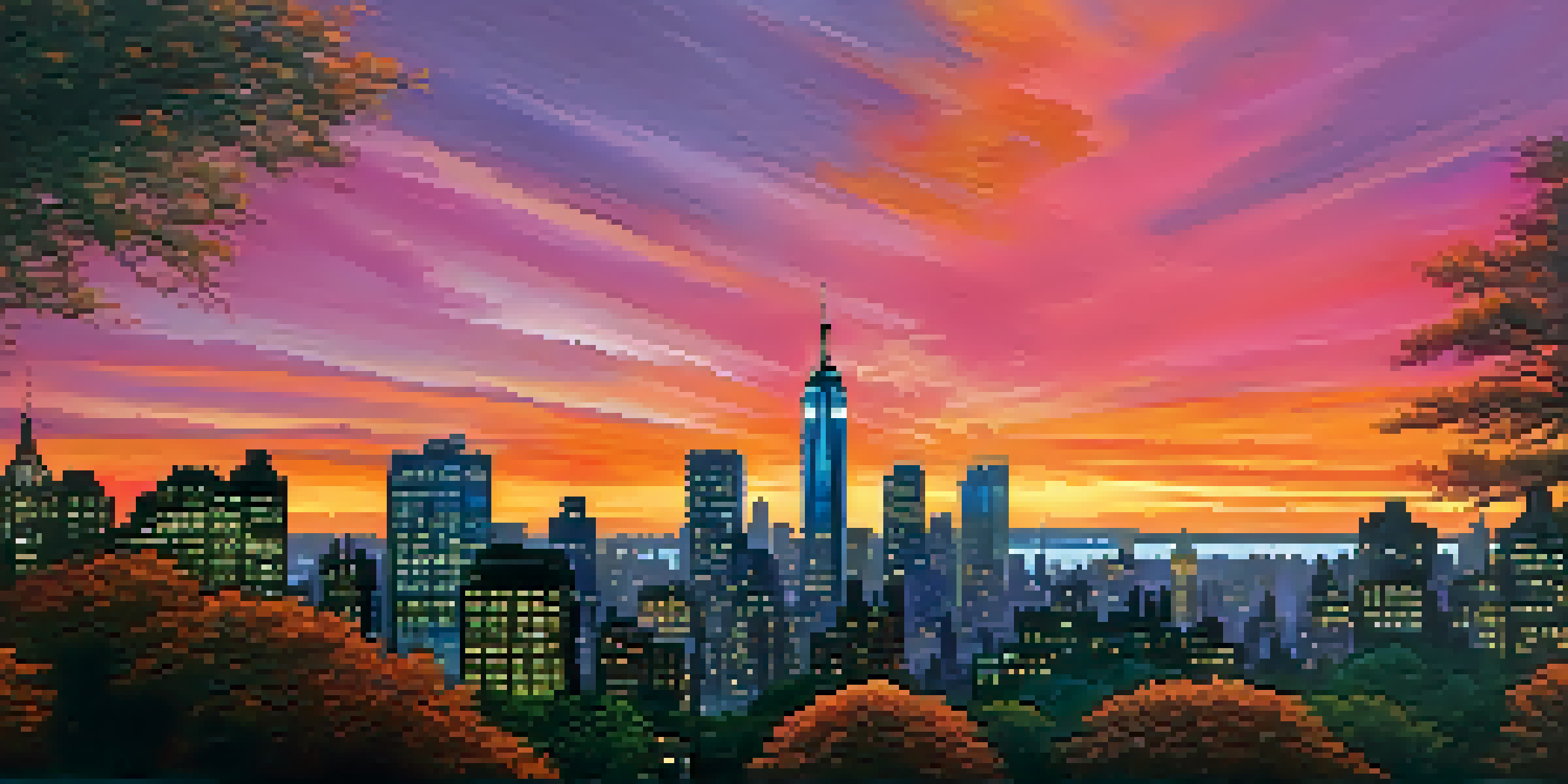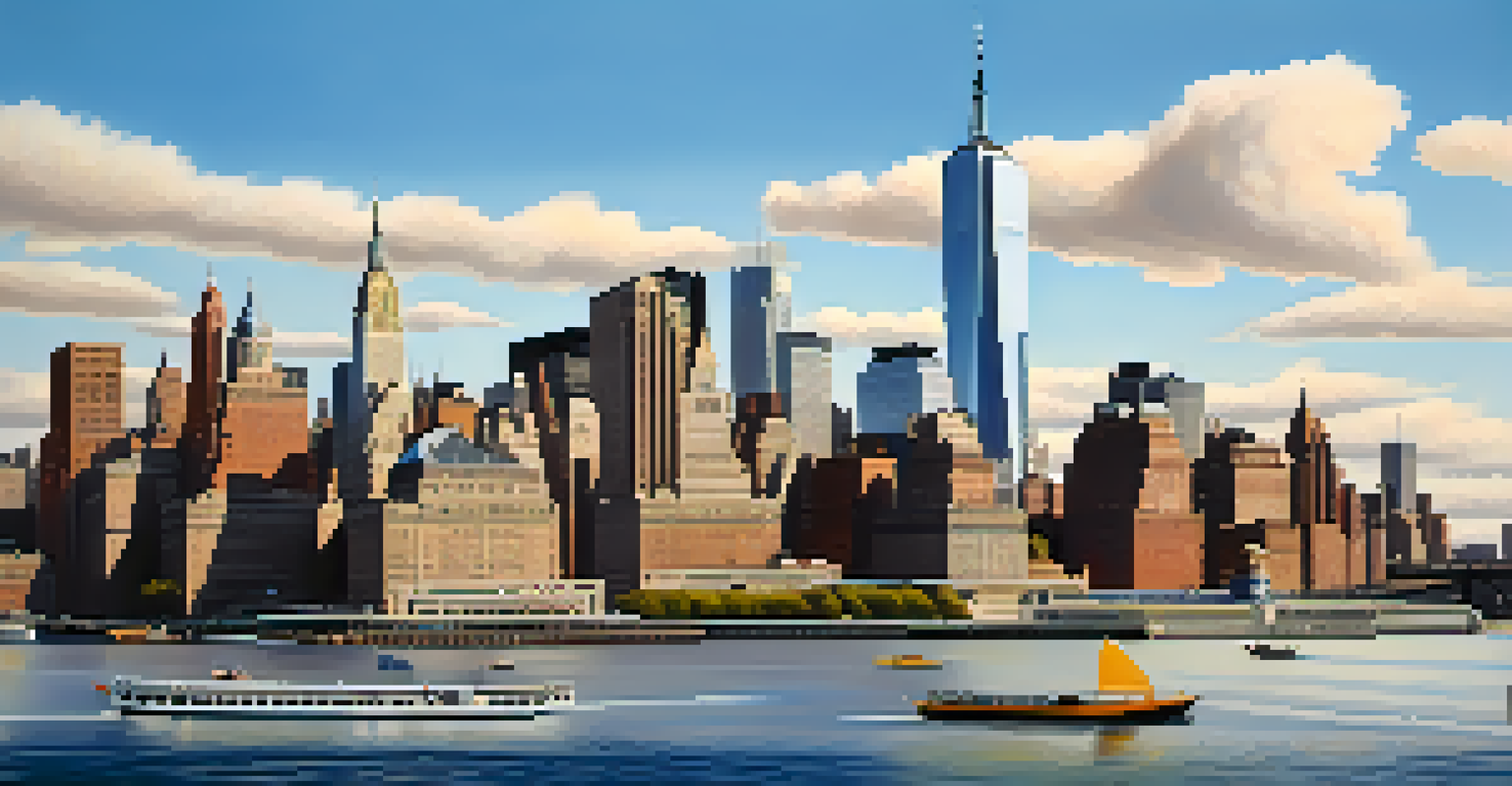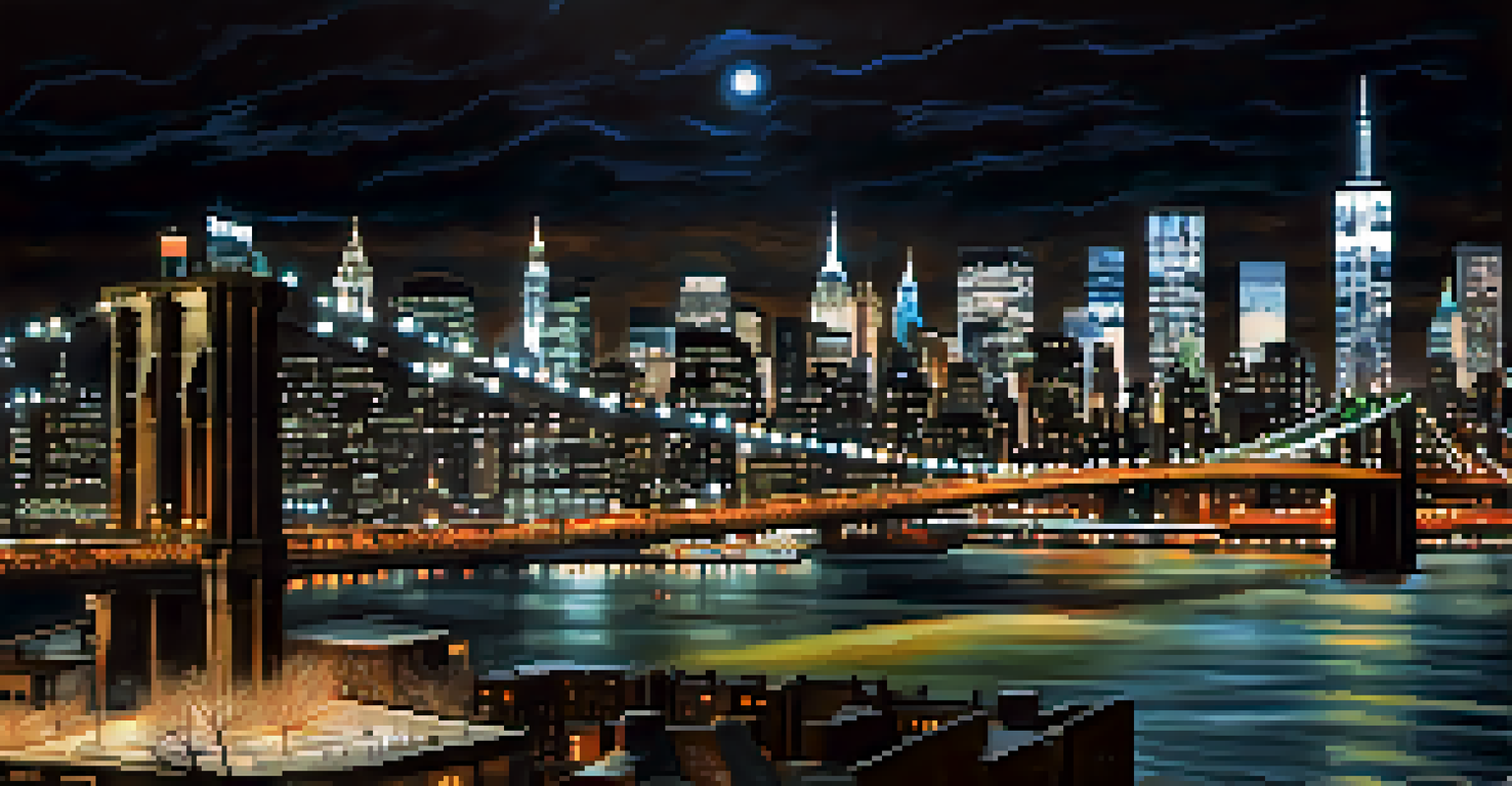The Influence of NYC's Skyline in Film and Television Storytelling

The Iconic NYC Skyline: A Cinematic Landmark
New York City's skyline is more than just a collection of buildings; it’s a defining character in film and television. From the towering Empire State Building to the sleek One World Trade Center, these structures evoke emotions and set the stage for countless stories. They serve as a backdrop that enhances the narrative, drawing viewers into the vibrant, bustling life of the city.
New York is not a city, it's a world.
Filmmakers often use the skyline to symbolize aspirations and dreams. For instance, in 'Sleepless in Seattle', the skyline represents the hope of love and new beginnings, perfectly framed against the city's twinkling lights. This visual storytelling technique helps audiences connect with the characters on a deeper level, making the skyline an integral part of the story.
Moreover, NYC’s skyline often reflects the mood of the film. A bright, clear day might signify optimism, while a dark, gloomy skyline can encapsulate despair or tension. This versatility in representation allows filmmakers to effectively communicate themes and emotions through one of the most recognizable cityscapes in the world.
NYC as a Character in Film and Television
In many films and TV shows, New York City is not just a setting; it’s a character in its own right. The vibrant streets, diverse neighborhoods, and iconic skyline breathe life into stories, making them feel authentic and relatable. Shows like 'Friends' and films like 'Breakfast at Tiffany's' showcase how the city’s essence is intertwined with the characters' journeys.

The skyline often signifies the hustle and bustle of city life, embodying the dreams and struggles of its inhabitants. For instance, in 'The Pursuit of Happyness', the protagonist’s journey through the city mirrors his quest for success, with the skyline serving as a constant reminder of what he aspires to achieve. This connection deepens the narrative and enhances viewer engagement.
NYC Skyline as a Storytelling Tool
The skyline serves as a powerful backdrop that enhances narratives, symbolizing dreams and emotions in film and television.
Furthermore, the skyline's depiction can change depending on the storyline. In darker narratives, such as 'The Dark Knight', the city can appear foreboding, emphasizing themes of chaos and conflict. This ability to convey varying tones through the skyline makes NYC an essential element in storytelling.
Cultural Significance of the NYC Skyline
The NYC skyline is a symbol of cultural diversity and innovation, representing the melting pot that is the city. This cultural significance is often reflected in films and television, where characters from various backgrounds come together against the backdrop of the skyline. Shows like 'In the Heights' highlight the richness of community and heritage, showcasing the city’s vibrancy.
The skyline is the fingerprint of a city, an expression of its soul.
Filmmakers frequently emphasize historical landmarks in the skyline to ground their stories in reality. For instance, the Twin Towers in 'The Secret Life of Walter Mitty' evoke nostalgia and reflect on the passage of time, connecting personal journeys with the city’s evolution. This interplay of history and storytelling enriches the narrative experience.
Through the lens of film and television, the skyline becomes a canvas on which stories of ambition, struggle, and triumph are painted. It’s not just about the buildings; it’s about the lives that unfold beneath them, shaping the narrative landscape of both the city and the screen.
The Skyline as a Symbol of Dreams
The New York City skyline is often portrayed as a symbol of dreams and aspirations. Many films depict characters moving to the city to chase their goals, with the skyline standing tall as a beacon of hope. For instance, in 'Annie', the skyline represents the dreams of a young girl seeking a better life, reinforcing the idea that NYC is a place where dreams can come true.
This symbolic representation resonates deeply with audiences, who often see themselves in these stories. The aspiration tied to the skyline is universal; it reflects the desire for success, love, and adventure. This connection makes the skyline an important storytelling device, capturing the hearts of viewers around the world.
NYC: A Character in Its Own Right
In many stories, New York City is portrayed not just as a setting but as a vital character that reflects the aspirations and struggles of its inhabitants.
Moreover, the skyline's evolving nature, with new buildings constantly rising, mirrors the ever-changing landscape of dreams. Each new structure signifies new opportunities and stories waiting to be told, ensuring that the NYC skyline remains a dynamic element in film and television.
Practical and Creative Filming Locations
Filmmakers often choose the NYC skyline for its breathtaking views and diverse locations. The skyline provides a stunning backdrop for various genres, from romantic comedies to action-packed thrillers. Locations like Brooklyn Bridge or Central Park offer practical filming spots that enhance the storytelling experience while showcasing the iconic skyline.
In addition to its visual appeal, the practical aspects of filming in NYC contribute to its popularity. The city offers a variety of urban settings, from high-rise apartments to bustling streets, all within close proximity. This accessibility allows filmmakers to create dynamic scenes that capture the essence of city life, all while keeping the skyline in view.
The skyline’s influence on the creative process is undeniable. Directors and cinematographers often design shots that intentionally include the skyline, ensuring it complements the narrative. This synergy between location and story elevates the overall production value, making the skyline an indispensable part of the filmmaking toolkit.
Iconic Moments Featuring the NYC Skyline
Many unforgettable cinematic moments are tied to the NYC skyline, solidifying its status as a cultural icon. Think of the scene in 'King Kong' where the giant ape climbs the Empire State Building—this moment is etched in film history, forever linking the skyline to themes of awe and adventure. Such scenes highlight how the skyline can become a pivotal point in storytelling.
Television also capitalizes on iconic skyline moments, often using aerial shots to establish the setting. For instance, the opening credits of 'How I Met Your Mother' feature sweeping views of the skyline, instantly immersing viewers into the vibrant world of NYC. These moments not only enhance the narrative but also create a lasting impression on audiences.
Future of NYC in Film and TV
As the city evolves, its skyline will continue to inspire filmmakers, offering fresh narratives and innovative storytelling opportunities.
These iconic moments create a sense of familiarity and nostalgia, making the skyline a beloved aspect of film and television. As viewers, we are transported into the story, feeling the pulse of the city through its towering structures and vibrant atmosphere.
The Future of NYC's Skyline in Storytelling
As New York City continues to evolve, so too will its skyline and its role in storytelling. New architectural designs and innovative structures will provide fresh backdrops for filmmakers and television creators. This ongoing transformation ensures that the skyline remains a dynamic character, adapting to the narratives that unfold within its shadow.
Emerging technologies, like virtual reality and augmented reality, will also influence how the skyline is portrayed. Filmmakers may experiment with new ways to integrate the skyline into their stories, making it more interactive and immersive for viewers. This evolution will open up exciting possibilities for storytelling in the future.

Ultimately, NYC's skyline will continue to inspire and shape film and television narratives. As a symbol of ambition, diversity, and resilience, it will remain a crucial part of the storytelling landscape, inviting audiences to dream alongside the characters who inhabit this iconic city.